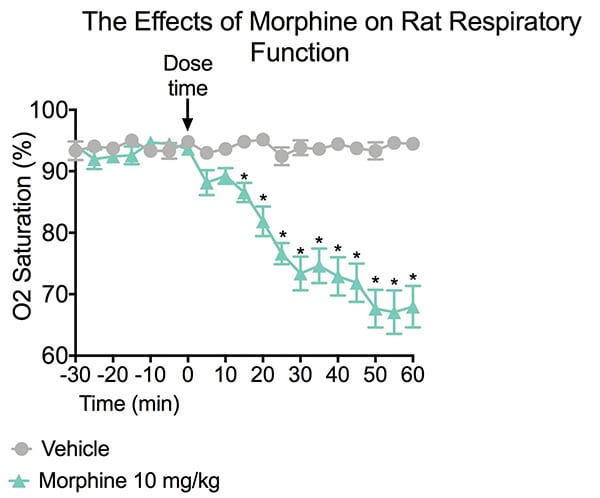Respiratory Depression Assay
Discover how Melior’s unique phenotypic screening platforms can uncover the untapped value of your candidate therapeutic
Respiratory depression is a significant side effect associated with opioid treatment of acute and chronic pain. Efforts to generate analgesics that dissociate pain relief from negative side effects are critical. Therefore many analgesic test article characterization studies incorporate respiratory depression as a measured endpoint.
Pulse oximetry is a relatively simple and noninvasive technology for monitoring heart rate, oxygen saturation, and breathing rate in rodents. The method involves temporarily harnessing animals with a special collar that emits a beam of dual-wavelength light with a sensitive photodetector. Oxygen saturation is particularly reliable parameter for evaluating respiratory depression.
The study summarized below examines the effects of morphine in a respiratory depression study using pulse oximetry. Blood oxygen saturation levels were assessed in conscious rats. Prior to dosing a 30 minute baseline was established for each animal. After dosing, a 5-second average of the oxygen saturation value was sampled every 5 minutes for 60 minutes.
Ready to get started or looking for a custom model?
Contact us today for more information about our bespoke research models and to discuss how we can help you answer your unique research questions.

A significant reduction in O2 saturation was found in rats treated with morphine compared to rats treated with vehicle. Data are mean ± SEM; **p<0.01 compared to vehicle (N=8).
The rodent pulse oximetry procedure to measure Respiratory Depression is most typically at least a 3-day procedure to account for 2 acclimation days where the animals are fitted with the pulse oximetry collars for about 1 hour periods. This is a non-invasive procedure that lends itself well to incorporating at several points over the course of a chronic model or treatment regimen.
Frequently Asked Questions
Respiratory depression is observed by a significant decrease in O2 saturation. This is done using a rodent pulse oximeter.
Absolutely! Measuring oxygen saturation in larger models (i.e., asthma, pulmonary edema, influenza, etc.) can contribute to a larger understanding of a drug candidates’ capabilities.
Morphine is well documented for causing respiratory depression in rats and mice.
Synonyms: Asthma, pulmonary inflammation, oxygen saturation, pulse oximetry



